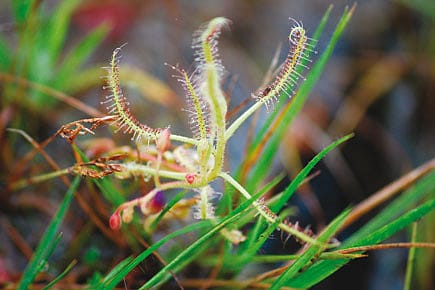Green Meat Eaters

68 km from Bangalore, a bunch of nature lovers discovers two rare species of carnivorous plants
On a warm October morning, members of Tumkur's Wildlife Aware Nature Club (WANC) met for their weekly stroll. To them, it was just another gratifying weekend spent in Karnataka's lush, ancient Devarayanadurga Reserve Forests.
Some way into their trek, they came across a group of plants with insects sticking out of them. Taken aback, they enlisted the help of biodiversity experts. To their delight, they were told that they had found two rare species of carnivorous plants—the Utricularia caerulea and Drosera indica. "We already know of two such plants in this area—the Drosera burmannii and the Utricularia aurea. So imagine our happiness at coming across two more," says BV Gundappa, chairman of the club. Their findings have been validated by biodiversity expert Harish Bhat and Professor K Sankara Rao, distinguished fellow at the Centre for Ecological Sciences at Bangalore's Indian Institute of Science.
"These are rare plants which become active during the monsoon season," says Bhat. "They derive nutrients from tiny insects like ants and grasshoppers." Insects are drawn to the plants in the hope of nectar and are then sucked into their digestive juices. It is said that some of the plants have been illegally exported. "I've heard that the Drosera is much in demand for purposes of research, but I don't have concrete information," says Bhat.
The members of WANC hope this will urge the local authorities and residents to intensify their conservation efforts in this rich forest area. In Karnataka, preservation and conservation activity has been limited to the Western Ghats. "In this area, even small patches are rich in biodiversity," says TVN Murthy, one of the members of the club.
2026 New Year Issue
Essays by Shashi Tharoor, Sumana Roy, Ram Madhav, Swapan Dasgupta, Carlo Pizzati, Manjari Chaturvedi, TCA Raghavan, Vinita Dawra Nangia, Rami Niranjan Desai, Shylashri Shankar, Roderick Matthews, Suvir Saran
Since it started in 1989 as part of World Wildlife Fund's (WWF) Nature Club Movement, these members have been helping the forest department in conducting biodiversity surveys, rescuing and rehabilitating snakes, organising wildlife camps and spreading awareness about the area's rich deposits of flora and fauna. "Though we dissociated with the WWF in 1994, we maintain close ties with the organisation," says Ameen Ahmed, a member.
